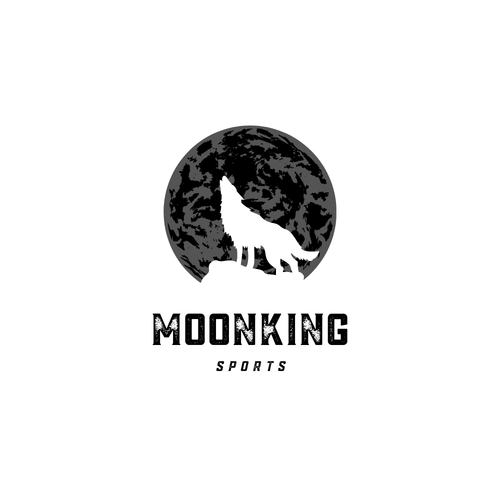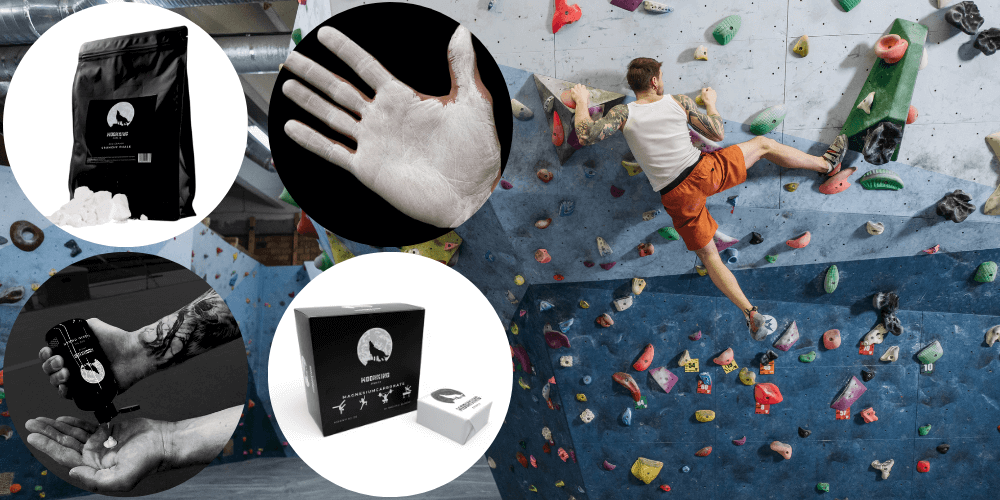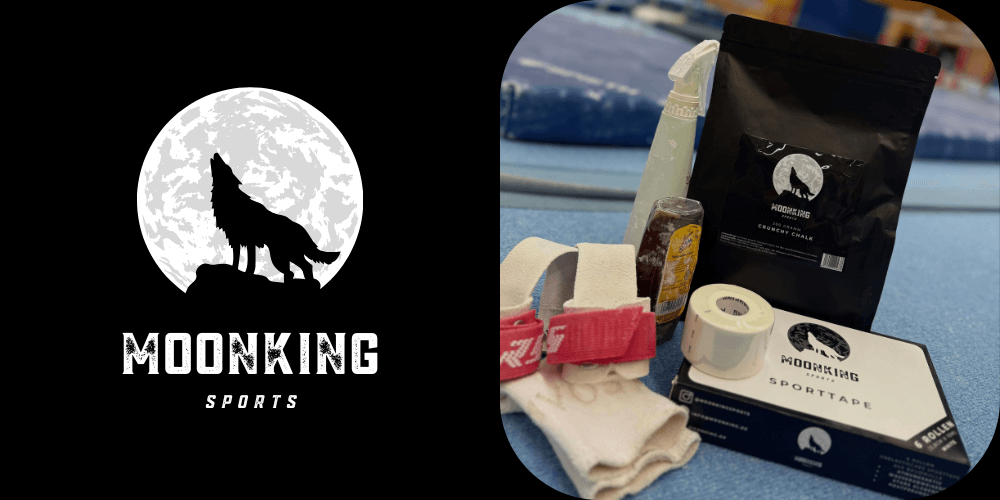Why chalk makes the difference for bouldering
When bouldering, every move, every hold—and every ounce of confidence in your own strength—counts. Even with perfect technique, a small slip-up can cost you everything. This is where bouldering chalk comes in: It can optimize your grip, give you more security, and help you push your limits.
As part of the MoonKing Sports team, we know from our own experience: reaching for your chalk bag is often the mental signal that you're about to enter your flow. And of course, in this article, we want to show you how to use chalk optimally for bouldering —from selection to application—so you can find the perfect chalk in our shop and get started right away.
In this article you will discover:
-
The types of chalk and their differences
-
How to find the right chalk for bouldering
-
Mistakes you should avoid
-
Tips for hand and skin care
-
Application steps for maximum grip
-
Indoor vs. outdoor use
-
Why your chalk can be a ritual
-
Our MoonKing chalk products – presented
-
Testimonials from the community
-
Final thoughts
1. What is chalk for bouldering – basics & function
Chalk , often called magnesia in German, is a fine magnesium carbonate that acts as a drying agent. It helps absorb moisture (sweat) from the skin's surface, keeping your hands dry and grippy. This property is especially crucial for bouldering—with its unpredictable movements, small holds, and high intensity.
Without chalk, you risk your hands slipping under heavy load. Even a minimal loss of friction can mean you can't hold a move—and your project falls. With high-quality bouldering chalk, you can minimize this vulnerability.
But not all chalk is created equal. There are different forms, qualities, and additives that influence how well it works—or how much it harms your skin. In the next sections, we'll look at these variations in detail.
2. The main types of chalk and their properties
2.1 Chalk powder (loose chalk)
-
Description: Finely ground, ready to use
-
Advantages: Flexible dosage, good distribution on the skin
-
Disadvantages: Dust development (especially in halls), rapid consumption
Chalk powder is often the first choice for many boulderers because it's uncomplicated. You can quickly re-chalk your hands during a short break. However, it has the disadvantage that the fine dust spreads throughout the gym, dirtying walls, and gym operators sometimes restrict its use.
2.2 Chalk block
-
Description: Compactly pressed, in blocks or small cubes
-
Advantages: Less dust, more durable, good portioning
-
Disadvantages: Must be crumbled or rubbed off, less flexibility
Many boulderers use chalk blocks because they're cleaner and produce less waste. You can carry them in your chalk bag and scrape off chunks as needed or press them directly onto your skin.
2.3 Liquid Chalk
-
Description: Liquid mixture that dries after application to skin
-
Advantages: Very good adhesion, hardly any dust, ideal for halls with strict rules
-
Disadvantages: May burn when applied to chapped skin
Liquid chalk is often used in powder or block form before climbing. It adheres well, forms a good base, and reduces the need for re-chalking. This is especially useful if you train in bouldering gyms that require low-dust rules.
2.4 Mixed forms & special chalks
Some products combine powder and liquid components or contain additional additives such as resins or flow agents for better grip or dust reduction. These variants can be useful if you have very specific requirements (e.g., sensitive skin, extremely sweaty hands). There is also a mix of fine powder and solid chunks, called "crunchy chalk."
3. How to choose the right chalk for bouldering
The right choice depends on several factors: your skin, the location, and your preferences. Here are the criteria we at MoonKing Sports pay particular attention to:
3.1 Skin compatibility & ingredients
Not all chalks are equally skin-friendly. Some contain additives that can irritate the skin, especially if it's injured or sensitive. Watch out for:
-
Purity (magnesium carbonate without unnecessary additives)
-
Absence of perfume or harsh chemicals
-
Good test results or certifications
Our team at MoonKing Sports focuses on gentle ingredients to ensure you get maximum grip with minimal skin irritation.
3.2 Dust development & environmental aspects
Many bouldering gyms have limits or regulations for dusty chalk. If you train a lot indoors, a low-dust product (e.g., liquid chalk or chalk blocks) is often more suitable. When bouldering outdoors, you should also consider how much of a mark you leave behind—the less chalk abrasion, the more environmentally friendly.
3.3 Liability & lasting effect
A good bouldering chalk shouldn't just stick once, but last as long as possible. If you reapply chalk after every move, you'll lose concentration and time. Therefore, it's worth choosing a product that adheres well and rarely needs to be reapplied.
3.4 Price & Yield
Cheaper chalk products are often less efficient or have a shorter shelf life. High-quality chalk that lasts longer and performs better can be more cost-effective in the long run—especially if you boulder regularly.
3.5 Interaction with your equipment
Your chalk bag, chalk wiper, and inner lining also influence how much chalk you lose and how well you can control it. A soft inner lining, a good closure, and a well-thought-out design make a big difference.
4. The most common mistakes when using chalk
Even professionals make mistakes – here are the most common ones you should avoid:
4.1 Too much magnesia at once
Many people think, "More is better." The result: layering, weaker adhesion, and more abrasion. It's better to work in small portions and tap off excess magnesia.
4.2 Leave old magnesia in the chalk bag
If your chalk becomes contaminated with sweat or dirt, it loses its effectiveness. Regularly cleaning your chalk bag and shaking out the chalk is essential.
4.3 Do not clean your hands beforehand
Grease, creams, or dirt on your skin will prevent the chalk from adhering properly. Therefore, wash your hands thoroughly before applying chalk.
4.4 No variation depending on the situation
Sometimes liquid chalk is better, sometimes powder or blocks – depending on the temperature, humidity, or gym rules. Rigidly using one type of chalk will limit you.
4.5 Neglecting skin care
Harsh chalk without proper care leads to cracks, abrasions, or chronic irritation. Healthy skin is just as important for grips as the chalk itself.

5. Skin and hand care – how to protect your hands
Daily training can take its toll on your skin. Here are our tips from the MoonKing Sports team:
5.1 After training: Wash thoroughly
Use gentle, pH-neutral soaps. Avoid harsh cleansers that further dry out your skin.
5.2 Moisturizing: Mandatory, not optional
After washing, use a good hand cream or special climber ointment. Apply a rich moisturizer in the evening.
5.3 Regular regeneration breaks
Give your skin time to heal between intense sessions. Overtraining quickly leads to micro-injuries.
5.4 Avoid weak spots
For open wounds or cracks: temporarily use less magnesia or switch to a gentler alternative. Avoid using liquid magnesia for now.
5.5 Keep nails short and well-groomed
Keeping your nails short will prevent you from cutting your skin when chalking or gripping.
6. Using chalk correctly – step by step
This is how you should ideally use your chalk for bouldering :
-
Clean and dry hands
Grease-free, clean, completely dry. -
Apply magnesia in measured doses
Take a moderate amount and spread it evenly on all fingers and the palm of your hand. -
Tap off excess magnesia
A thin, even layer is better than a thick layer of chalk. -
Re-chalk if necessary, but sparingly
If necessary, add small amounts – do not “empty”. -
Close and organize your chalk bag well
This keeps the magnesia dry, clean and available. -
Regularly knock out / clean
Dust accumulation and contamination reduce the effect over time.
7. Indoor vs. Outdoor – What to consider when using chalk
7.1 Indoor (halls)
-
Many halls only allow low-dust magnesia or liquid chalk
-
Pay attention to hall rules and be considerate to others
-
Pressure on good packaging and closure (e.g. chalk bags with zipper)
7.2 Outdoor (rocks, nature)
-
Protect the environment: Avoid chalk abrasion if possible
-
Work cleanly, leave no white marks
-
Consider weather conditions (humidity, wind)
8. Chalk for bouldering & mental aspects
Chalk is not only physically effective – for many people, reaching for the chalk bag is a mental ritual: a signal for focus, concentration and activation.
Rituals before performance tasks help you get into the flow. Your chalk ritual (unpacking, applying, and tapping) can therefore be a fundamental part of your climbing process.
If your mind is already tuned in when you reach for the chalk bag, you're more likely to be able to perform rough movements cleanly - with calmness, control, and precision.
9. MoonKing Sports ‑ Chalk: Our Products & Recommendations
As part of the MoonKing Sports team, we would like to show you what we value most in our chalk – and which variants might be ideal for you:
9.1 MoonKing Sports Crunchy Chalk (mix of powder and nuggets)
-
Mix of powder and nuggets
-
Particularly popular in competitive sports
-
Ideal if you want to re-chalk quickly and flexibly
9.2 MoonKing Sports Chalk Block
-
Compactly pressed, less dust
-
Durable and efficient
-
Perfect for halls with low-dust requirements
9.3 MoonKing Sports Liquid Chalk
-
Applied liquid, then dried
-
Very clean solution, ideal indoors & for sensitive skin
-
Good alternative solution for days when you want maximum grip with minimal dust
Every chalk product in our shop undergoes tests for adhesion, skin compatibility, and longevity. We want you to not only get a grip advantage, but also enjoy it long-term – without skin problems.
10. Voices from the community
"I was skeptical whether the liquid chalk from MoonKing Sports was really that good. Now I don't even want regular chalk anymore – no dust, but great grip."
— Jana, enthusiastic boulderer
"The block chalk is super handy for my indoor sessions. Since switching, I've been wasting less chalk."
— Erik, hobby climber
"My skin is often sensitive—but after two weeks of use, I notice it has recovered, while my grip remains stable."
— Mia, Cross Climber
This feedback inspires us every day at MoonKing Sports to further optimize our products and to engage closely with our community.
11. FAQ – your questions about chalk for bouldering , our answers
Q1: Is magnesia harmful to health?
No, if it's pure magnesium carbonate. Look for high-quality products without harsh additives. If you have sensitive skin, test first and switch to milder versions if necessary.
Q2: How often do I need to re-chalk?
This depends on your magnesia, intensity, and environment. A good magnesia often lasts for several strokes. Re-chalking should be done sparingly and in measured doses.
Q3: Can I take magnesia on the plane?
Generally yes – but check the airline's regulations. Liquid chalk could be considered a liquid; in this case, the 100ml version of our liquid chalk would be suitable.
Q4: What to do if your skin is cracked?
Rest, care, use powder or blocks instead of liquid magnesia until the skin heals.
Q5: Can I mix my own magnesia?
Yes – for example, with anti-caking agents or antibacterial additives. But you risk intolerances or quality issues. We recommend tested products like our MoonKing Sports chalk variants.
12. Grip strength & technique – what really matters
In addition to equipment and route experience, your grip strength plays a crucial role in bouldering. Especially on small ledges, slopers, or large volumes, it becomes clear how important it is not only to pull hard but also to hold on. Finger strength for bouldering can be trained – but it requires patience, systematic approach, and regular regeneration.
Effective bouldering training methods include hangboarding sessions, controlled isometric training, or targeted work on weak points such as open pinches or one-arm holds. Technique often makes the difference: Learning to distribute body weight optimally and build tension throughout the entire body saves energy and improves control.
The mental component should not be underestimated either: Visualization, breathing techniques, and confidence in your own movements can help you master difficult passages with confidence. Those who compete with focus and efficiency not only improve their performance but also reduce the risk of injury due to overexertion or loss of control.
13. How to make the most of this post
-
Remember the differences between powder, blocks and liquid chalk – this is how you find your ideal magnesia
-
Test and combine variations – e.g. liquid magnesia for indoors, powder for outdoors
-
Use our MoonKing Sports products – they are tailored to your needs
-
Click into our shop and discover the right chalk package for you
-
Stay in our community : Feedback, product tests and new variants are waiting
Final thoughts
Chalk for bouldering is far more than just a tool—it's a performance booster, a psychological trigger, and a daily companion on your bouldering journey. If you find the right chalk and use it wisely, you'll feel yourself reach a new level of grip—with more control, confidence, and flow.
We at MoonKing Sports are convinced that your next bouldering success could begin with the right chalk. So, take a look around our shop, find your ideal option, and get started right away.















